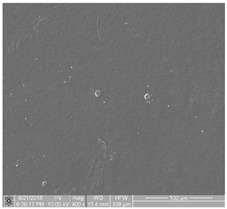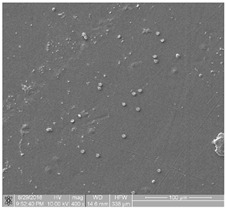Table 1.
Ordinal thrombogenicity scale together with description and exemplary images of surface of the sample belonging to a given class [41].
| Class | Description | Example |
|---|---|---|
| 0 | contains samples characterized by minimal thrombogenicity: separated platelets of low diverse level, no platelet aggregates |

|
| 1 | contains samples characterized by very low-degree thrombogenicity: a dozen or so adhered blood platelets not creating aggregates |

|
| 2 | contains samples characterized by very low-degree thrombogenicity: several dozen of visible platelets which can be present as single, separated aggregates with a small area |

|
| 3 | contains samples characterized by average-degree thrombogenicity: biological material mainly comprises aggregates larger than individual blood platelets |

|
| 4 | contains samples characterized by high-degree thrombogenicity: sample is covered with highly differentiated biological material, and the individual objects are connected with each other without possibility of separating them |

|
| 5 | contains samples characterized by very high-degree thrombogenicity: platelets are highly differentiated and form numerous aggregates, which are connected with each other without possibility of separating and counting objects |

|
